A Comprehensive Analysis of Leadership and Management at Toyota
VerifiedAdded on 2020/10/05
|15
|4498
|210
Report
AI Summary
This report delves into the leadership and management practices of Toyota Corporation, examining the roles of managers and leaders within the organization. It explores the company's background, management structure, and defines the distinctions between managers and leaders, analyzing their functions in various situations. The report highlights key leadership theories, including situational leadership, contingency management, and system theory, evaluating their strengths and weaknesses. It also addresses operational management within Toyota, defining functional responsibilities and evaluating the impact of external business environment factors on decision-making. The analysis covers approaches to improving operational efficiency and offers recommendations for future improvements, emphasizing the crucial impact of managers and leaders on the organization's growth and development, and the importance of adapting leadership styles to specific situations and contexts. The report concludes with a discussion of how the company can implement situational leadership approaches to improve overall organizational efficiency.

TITLE
Paraphrase This Document
Need a fresh take? Get an instant paraphrase of this document with our AI Paraphraser
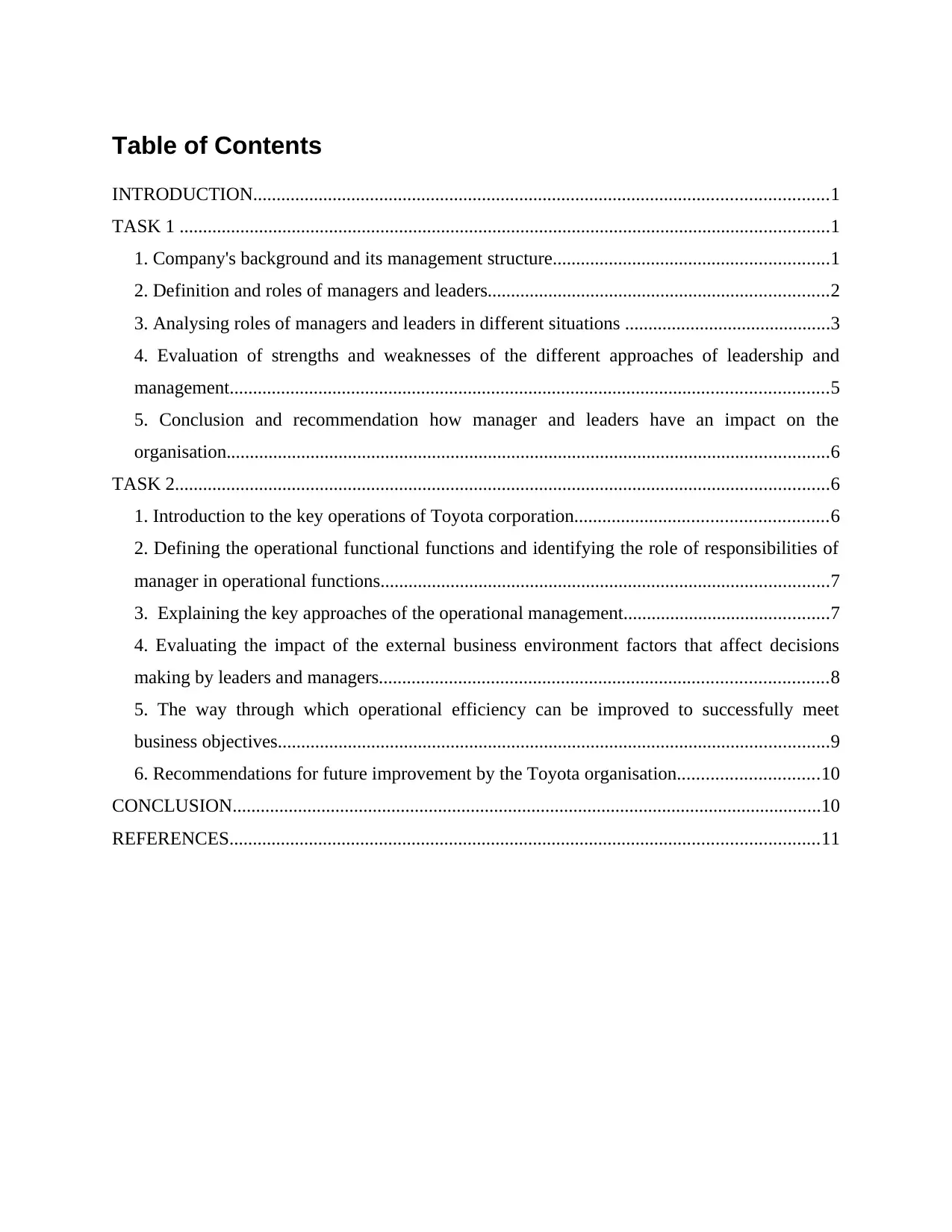
Table of Contents
INTRODUCTION...........................................................................................................................1
TASK 1 ...........................................................................................................................................1
1. Company's background and its management structure...........................................................1
2. Definition and roles of managers and leaders.........................................................................2
3. Analysing roles of managers and leaders in different situations ............................................3
4. Evaluation of strengths and weaknesses of the different approaches of leadership and
management................................................................................................................................5
5. Conclusion and recommendation how manager and leaders have an impact on the
organisation.................................................................................................................................6
TASK 2............................................................................................................................................6
1. Introduction to the key operations of Toyota corporation......................................................6
2. Defining the operational functional functions and identifying the role of responsibilities of
manager in operational functions................................................................................................7
3. Explaining the key approaches of the operational management............................................7
4. Evaluating the impact of the external business environment factors that affect decisions
making by leaders and managers................................................................................................8
5. The way through which operational efficiency can be improved to successfully meet
business objectives......................................................................................................................9
6. Recommendations for future improvement by the Toyota organisation..............................10
CONCLUSION..............................................................................................................................10
REFERENCES..............................................................................................................................11
INTRODUCTION...........................................................................................................................1
TASK 1 ...........................................................................................................................................1
1. Company's background and its management structure...........................................................1
2. Definition and roles of managers and leaders.........................................................................2
3. Analysing roles of managers and leaders in different situations ............................................3
4. Evaluation of strengths and weaknesses of the different approaches of leadership and
management................................................................................................................................5
5. Conclusion and recommendation how manager and leaders have an impact on the
organisation.................................................................................................................................6
TASK 2............................................................................................................................................6
1. Introduction to the key operations of Toyota corporation......................................................6
2. Defining the operational functional functions and identifying the role of responsibilities of
manager in operational functions................................................................................................7
3. Explaining the key approaches of the operational management............................................7
4. Evaluating the impact of the external business environment factors that affect decisions
making by leaders and managers................................................................................................8
5. The way through which operational efficiency can be improved to successfully meet
business objectives......................................................................................................................9
6. Recommendations for future improvement by the Toyota organisation..............................10
CONCLUSION..............................................................................................................................10
REFERENCES..............................................................................................................................11
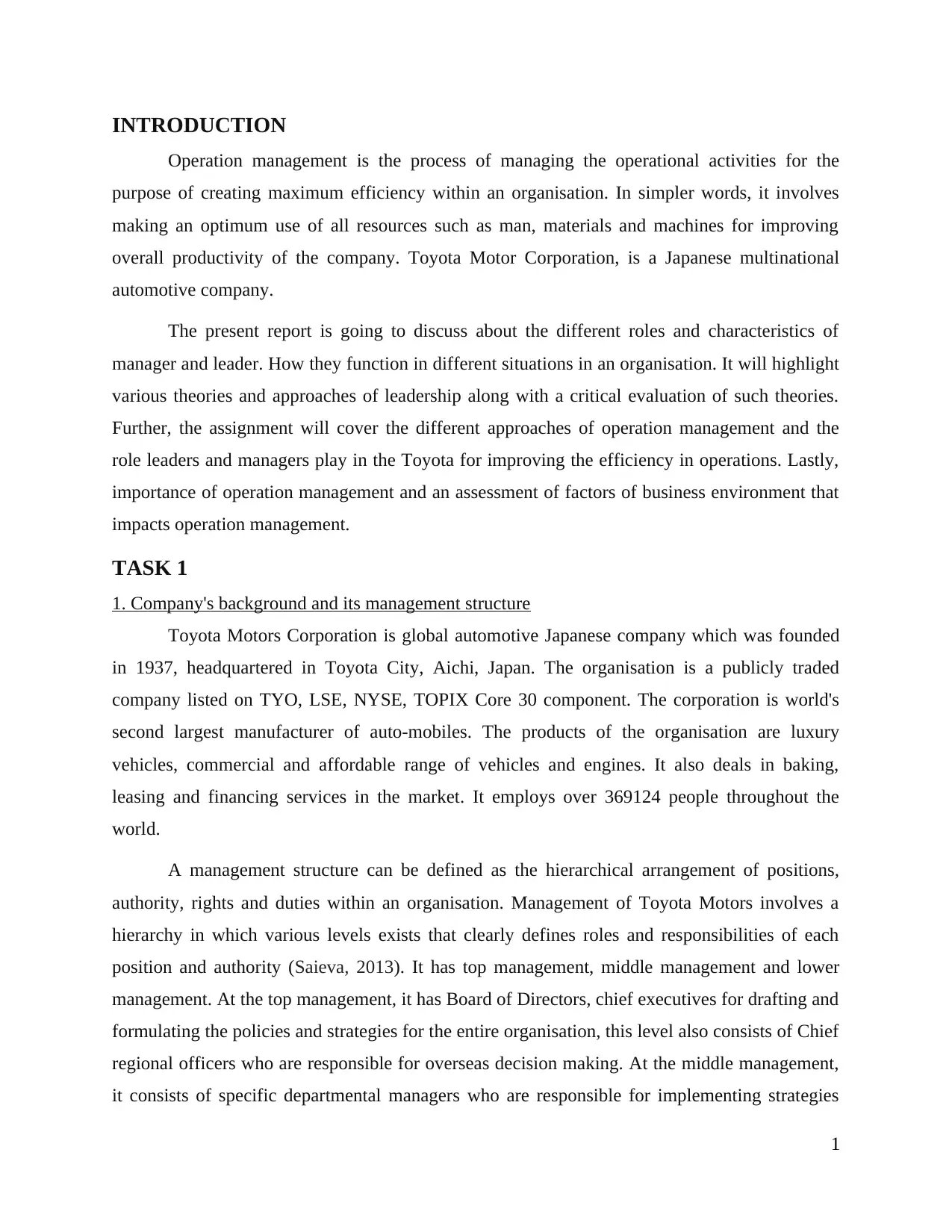
INTRODUCTION
Operation management is the process of managing the operational activities for the
purpose of creating maximum efficiency within an organisation. In simpler words, it involves
making an optimum use of all resources such as man, materials and machines for improving
overall productivity of the company. Toyota Motor Corporation, is a Japanese multinational
automotive company.
The present report is going to discuss about the different roles and characteristics of
manager and leader. How they function in different situations in an organisation. It will highlight
various theories and approaches of leadership along with a critical evaluation of such theories.
Further, the assignment will cover the different approaches of operation management and the
role leaders and managers play in the Toyota for improving the efficiency in operations. Lastly,
importance of operation management and an assessment of factors of business environment that
impacts operation management.
TASK 1
1. Company's background and its management structure
Toyota Motors Corporation is global automotive Japanese company which was founded
in 1937, headquartered in Toyota City, Aichi, Japan. The organisation is a publicly traded
company listed on TYO, LSE, NYSE, TOPIX Core 30 component. The corporation is world's
second largest manufacturer of auto-mobiles. The products of the organisation are luxury
vehicles, commercial and affordable range of vehicles and engines. It also deals in baking,
leasing and financing services in the market. It employs over 369124 people throughout the
world.
A management structure can be defined as the hierarchical arrangement of positions,
authority, rights and duties within an organisation. Management of Toyota Motors involves a
hierarchy in which various levels exists that clearly defines roles and responsibilities of each
position and authority (Saieva, 2013). It has top management, middle management and lower
management. At the top management, it has Board of Directors, chief executives for drafting and
formulating the policies and strategies for the entire organisation, this level also consists of Chief
regional officers who are responsible for overseas decision making. At the middle management,
it consists of specific departmental managers who are responsible for implementing strategies
1
Operation management is the process of managing the operational activities for the
purpose of creating maximum efficiency within an organisation. In simpler words, it involves
making an optimum use of all resources such as man, materials and machines for improving
overall productivity of the company. Toyota Motor Corporation, is a Japanese multinational
automotive company.
The present report is going to discuss about the different roles and characteristics of
manager and leader. How they function in different situations in an organisation. It will highlight
various theories and approaches of leadership along with a critical evaluation of such theories.
Further, the assignment will cover the different approaches of operation management and the
role leaders and managers play in the Toyota for improving the efficiency in operations. Lastly,
importance of operation management and an assessment of factors of business environment that
impacts operation management.
TASK 1
1. Company's background and its management structure
Toyota Motors Corporation is global automotive Japanese company which was founded
in 1937, headquartered in Toyota City, Aichi, Japan. The organisation is a publicly traded
company listed on TYO, LSE, NYSE, TOPIX Core 30 component. The corporation is world's
second largest manufacturer of auto-mobiles. The products of the organisation are luxury
vehicles, commercial and affordable range of vehicles and engines. It also deals in baking,
leasing and financing services in the market. It employs over 369124 people throughout the
world.
A management structure can be defined as the hierarchical arrangement of positions,
authority, rights and duties within an organisation. Management of Toyota Motors involves a
hierarchy in which various levels exists that clearly defines roles and responsibilities of each
position and authority (Saieva, 2013). It has top management, middle management and lower
management. At the top management, it has Board of Directors, chief executives for drafting and
formulating the policies and strategies for the entire organisation, this level also consists of Chief
regional officers who are responsible for overseas decision making. At the middle management,
it consists of specific departmental managers who are responsible for implementing strategies
1
⊘ This is a preview!⊘
Do you want full access?
Subscribe today to unlock all pages.

Trusted by 1+ million students worldwide
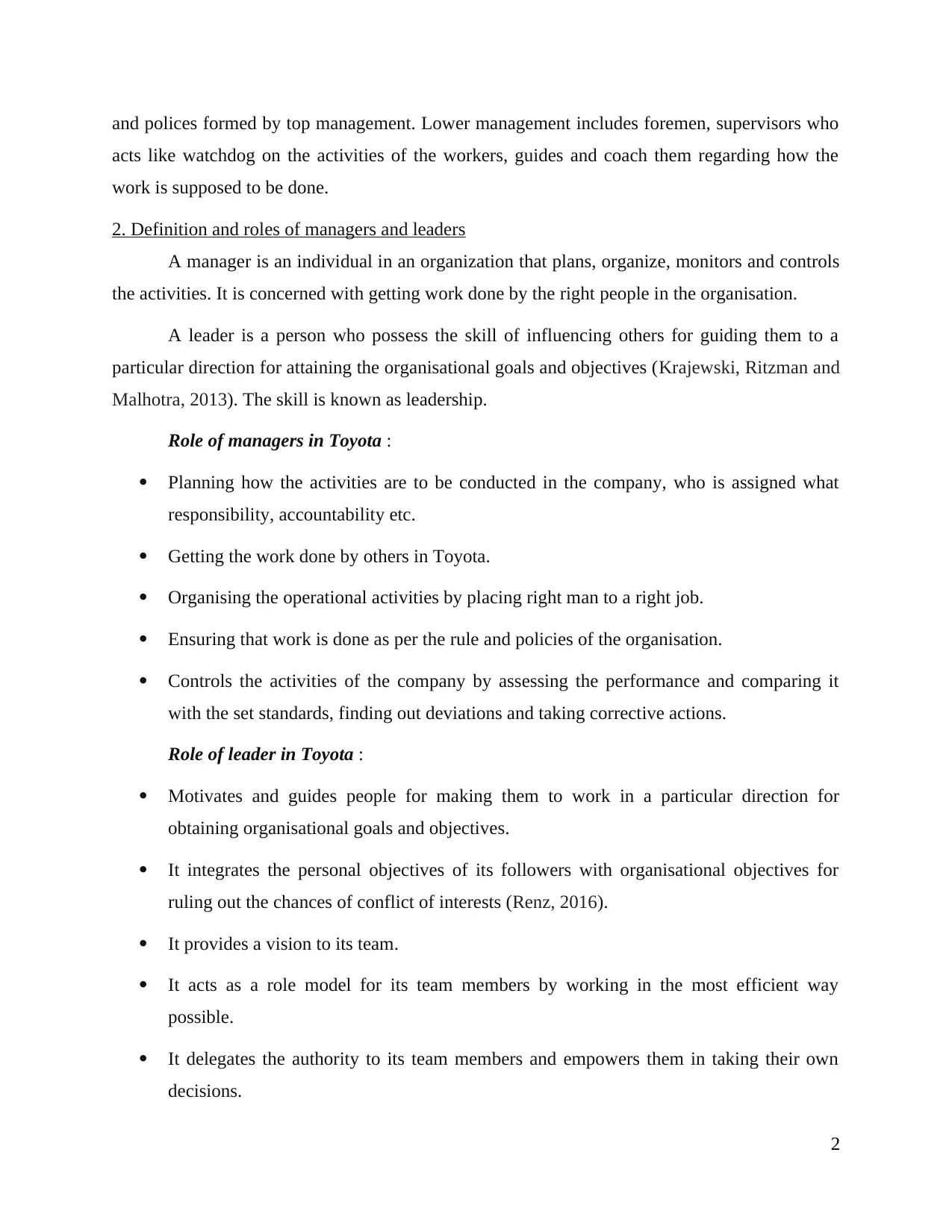
and polices formed by top management. Lower management includes foremen, supervisors who
acts like watchdog on the activities of the workers, guides and coach them regarding how the
work is supposed to be done.
2. Definition and roles of managers and leaders
A manager is an individual in an organization that plans, organize, monitors and controls
the activities. It is concerned with getting work done by the right people in the organisation.
A leader is a person who possess the skill of influencing others for guiding them to a
particular direction for attaining the organisational goals and objectives (Krajewski, Ritzman and
Malhotra, 2013). The skill is known as leadership.
Role of managers in Toyota :
Planning how the activities are to be conducted in the company, who is assigned what
responsibility, accountability etc.
Getting the work done by others in Toyota.
Organising the operational activities by placing right man to a right job.
Ensuring that work is done as per the rule and policies of the organisation.
Controls the activities of the company by assessing the performance and comparing it
with the set standards, finding out deviations and taking corrective actions.
Role of leader in Toyota :
Motivates and guides people for making them to work in a particular direction for
obtaining organisational goals and objectives.
It integrates the personal objectives of its followers with organisational objectives for
ruling out the chances of conflict of interests (Renz, 2016).
It provides a vision to its team.
It acts as a role model for its team members by working in the most efficient way
possible.
It delegates the authority to its team members and empowers them in taking their own
decisions.
2
acts like watchdog on the activities of the workers, guides and coach them regarding how the
work is supposed to be done.
2. Definition and roles of managers and leaders
A manager is an individual in an organization that plans, organize, monitors and controls
the activities. It is concerned with getting work done by the right people in the organisation.
A leader is a person who possess the skill of influencing others for guiding them to a
particular direction for attaining the organisational goals and objectives (Krajewski, Ritzman and
Malhotra, 2013). The skill is known as leadership.
Role of managers in Toyota :
Planning how the activities are to be conducted in the company, who is assigned what
responsibility, accountability etc.
Getting the work done by others in Toyota.
Organising the operational activities by placing right man to a right job.
Ensuring that work is done as per the rule and policies of the organisation.
Controls the activities of the company by assessing the performance and comparing it
with the set standards, finding out deviations and taking corrective actions.
Role of leader in Toyota :
Motivates and guides people for making them to work in a particular direction for
obtaining organisational goals and objectives.
It integrates the personal objectives of its followers with organisational objectives for
ruling out the chances of conflict of interests (Renz, 2016).
It provides a vision to its team.
It acts as a role model for its team members by working in the most efficient way
possible.
It delegates the authority to its team members and empowers them in taking their own
decisions.
2
Paraphrase This Document
Need a fresh take? Get an instant paraphrase of this document with our AI Paraphraser
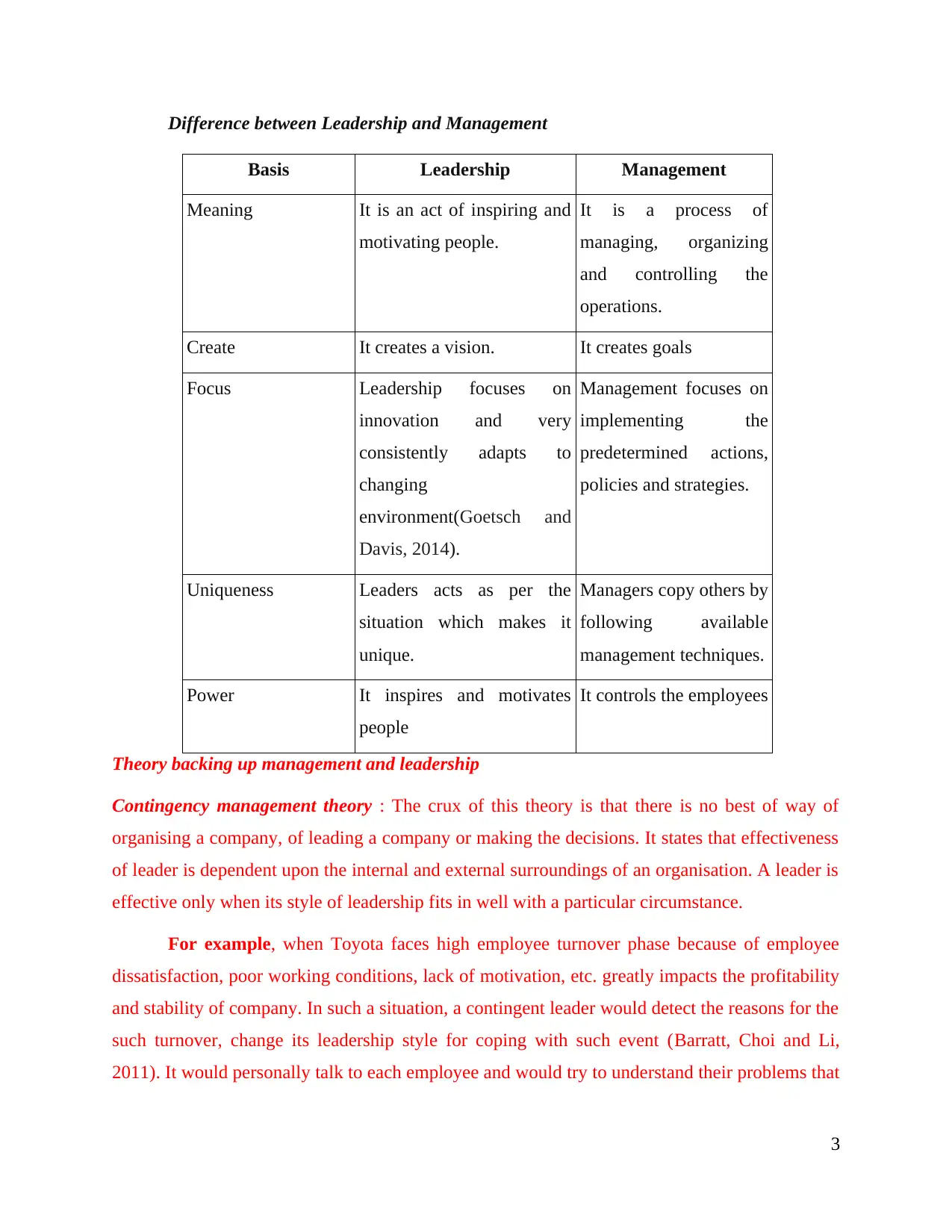
Difference between Leadership and Management
Basis Leadership Management
Meaning It is an act of inspiring and
motivating people.
It is a process of
managing, organizing
and controlling the
operations.
Create It creates a vision. It creates goals
Focus Leadership focuses on
innovation and very
consistently adapts to
changing
environment(Goetsch and
Davis, 2014).
Management focuses on
implementing the
predetermined actions,
policies and strategies.
Uniqueness Leaders acts as per the
situation which makes it
unique.
Managers copy others by
following available
management techniques.
Power It inspires and motivates
people
It controls the employees
Theory backing up management and leadership
Contingency management theory : The crux of this theory is that there is no best of way of
organising a company, of leading a company or making the decisions. It states that effectiveness
of leader is dependent upon the internal and external surroundings of an organisation. A leader is
effective only when its style of leadership fits in well with a particular circumstance.
For example, when Toyota faces high employee turnover phase because of employee
dissatisfaction, poor working conditions, lack of motivation, etc. greatly impacts the profitability
and stability of company. In such a situation, a contingent leader would detect the reasons for the
such turnover, change its leadership style for coping with such event (Barratt, Choi and Li,
2011). It would personally talk to each employee and would try to understand their problems that
3
Basis Leadership Management
Meaning It is an act of inspiring and
motivating people.
It is a process of
managing, organizing
and controlling the
operations.
Create It creates a vision. It creates goals
Focus Leadership focuses on
innovation and very
consistently adapts to
changing
environment(Goetsch and
Davis, 2014).
Management focuses on
implementing the
predetermined actions,
policies and strategies.
Uniqueness Leaders acts as per the
situation which makes it
unique.
Managers copy others by
following available
management techniques.
Power It inspires and motivates
people
It controls the employees
Theory backing up management and leadership
Contingency management theory : The crux of this theory is that there is no best of way of
organising a company, of leading a company or making the decisions. It states that effectiveness
of leader is dependent upon the internal and external surroundings of an organisation. A leader is
effective only when its style of leadership fits in well with a particular circumstance.
For example, when Toyota faces high employee turnover phase because of employee
dissatisfaction, poor working conditions, lack of motivation, etc. greatly impacts the profitability
and stability of company. In such a situation, a contingent leader would detect the reasons for the
such turnover, change its leadership style for coping with such event (Barratt, Choi and Li,
2011). It would personally talk to each employee and would try to understand their problems that
3
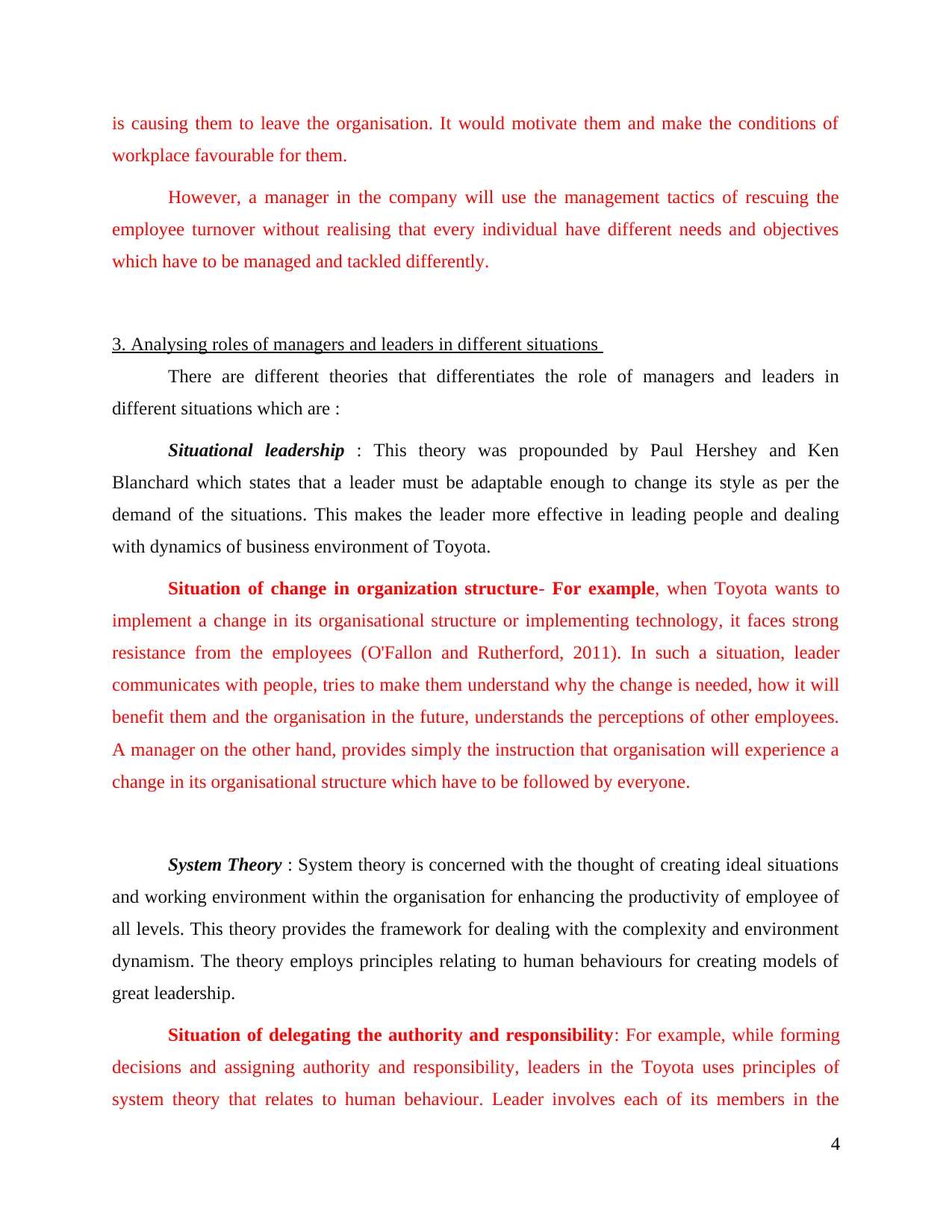
is causing them to leave the organisation. It would motivate them and make the conditions of
workplace favourable for them.
However, a manager in the company will use the management tactics of rescuing the
employee turnover without realising that every individual have different needs and objectives
which have to be managed and tackled differently.
3. Analysing roles of managers and leaders in different situations
There are different theories that differentiates the role of managers and leaders in
different situations which are :
Situational leadership : This theory was propounded by Paul Hershey and Ken
Blanchard which states that a leader must be adaptable enough to change its style as per the
demand of the situations. This makes the leader more effective in leading people and dealing
with dynamics of business environment of Toyota.
Situation of change in organization structure- For example, when Toyota wants to
implement a change in its organisational structure or implementing technology, it faces strong
resistance from the employees (O'Fallon and Rutherford, 2011). In such a situation, leader
communicates with people, tries to make them understand why the change is needed, how it will
benefit them and the organisation in the future, understands the perceptions of other employees.
A manager on the other hand, provides simply the instruction that organisation will experience a
change in its organisational structure which have to be followed by everyone.
System Theory : System theory is concerned with the thought of creating ideal situations
and working environment within the organisation for enhancing the productivity of employee of
all levels. This theory provides the framework for dealing with the complexity and environment
dynamism. The theory employs principles relating to human behaviours for creating models of
great leadership.
Situation of delegating the authority and responsibility: For example, while forming
decisions and assigning authority and responsibility, leaders in the Toyota uses principles of
system theory that relates to human behaviour. Leader involves each of its members in the
4
workplace favourable for them.
However, a manager in the company will use the management tactics of rescuing the
employee turnover without realising that every individual have different needs and objectives
which have to be managed and tackled differently.
3. Analysing roles of managers and leaders in different situations
There are different theories that differentiates the role of managers and leaders in
different situations which are :
Situational leadership : This theory was propounded by Paul Hershey and Ken
Blanchard which states that a leader must be adaptable enough to change its style as per the
demand of the situations. This makes the leader more effective in leading people and dealing
with dynamics of business environment of Toyota.
Situation of change in organization structure- For example, when Toyota wants to
implement a change in its organisational structure or implementing technology, it faces strong
resistance from the employees (O'Fallon and Rutherford, 2011). In such a situation, leader
communicates with people, tries to make them understand why the change is needed, how it will
benefit them and the organisation in the future, understands the perceptions of other employees.
A manager on the other hand, provides simply the instruction that organisation will experience a
change in its organisational structure which have to be followed by everyone.
System Theory : System theory is concerned with the thought of creating ideal situations
and working environment within the organisation for enhancing the productivity of employee of
all levels. This theory provides the framework for dealing with the complexity and environment
dynamism. The theory employs principles relating to human behaviours for creating models of
great leadership.
Situation of delegating the authority and responsibility: For example, while forming
decisions and assigning authority and responsibility, leaders in the Toyota uses principles of
system theory that relates to human behaviour. Leader involves each of its members in the
4
⊘ This is a preview!⊘
Do you want full access?
Subscribe today to unlock all pages.

Trusted by 1+ million students worldwide
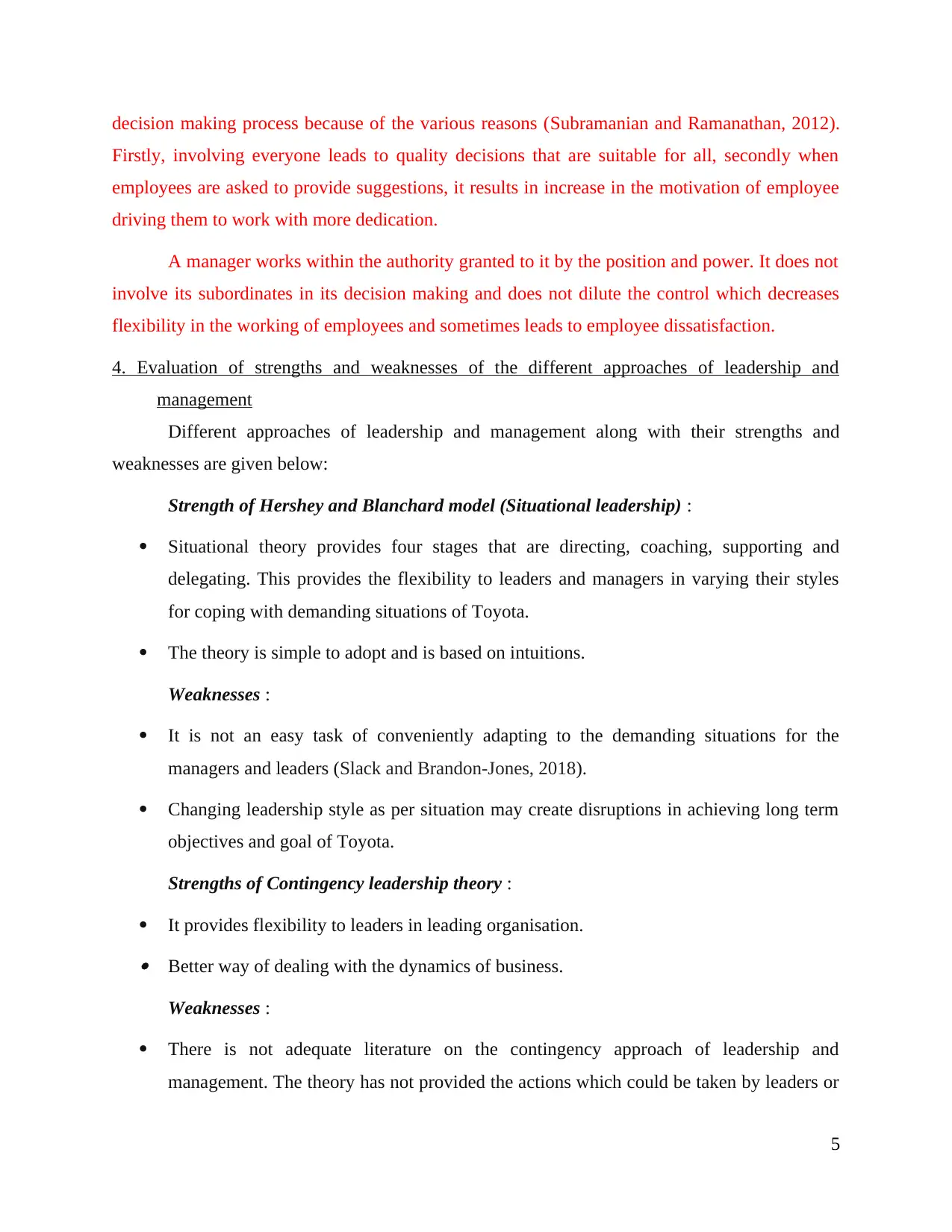
decision making process because of the various reasons (Subramanian and Ramanathan, 2012).
Firstly, involving everyone leads to quality decisions that are suitable for all, secondly when
employees are asked to provide suggestions, it results in increase in the motivation of employee
driving them to work with more dedication.
A manager works within the authority granted to it by the position and power. It does not
involve its subordinates in its decision making and does not dilute the control which decreases
flexibility in the working of employees and sometimes leads to employee dissatisfaction.
4. Evaluation of strengths and weaknesses of the different approaches of leadership and
management
Different approaches of leadership and management along with their strengths and
weaknesses are given below:
Strength of Hershey and Blanchard model (Situational leadership) :
Situational theory provides four stages that are directing, coaching, supporting and
delegating. This provides the flexibility to leaders and managers in varying their styles
for coping with demanding situations of Toyota.
The theory is simple to adopt and is based on intuitions.
Weaknesses :
It is not an easy task of conveniently adapting to the demanding situations for the
managers and leaders (Slack and Brandon-Jones, 2018).
Changing leadership style as per situation may create disruptions in achieving long term
objectives and goal of Toyota.
Strengths of Contingency leadership theory :
It provides flexibility to leaders in leading organisation. Better way of dealing with the dynamics of business.
Weaknesses :
There is not adequate literature on the contingency approach of leadership and
management. The theory has not provided the actions which could be taken by leaders or
5
Firstly, involving everyone leads to quality decisions that are suitable for all, secondly when
employees are asked to provide suggestions, it results in increase in the motivation of employee
driving them to work with more dedication.
A manager works within the authority granted to it by the position and power. It does not
involve its subordinates in its decision making and does not dilute the control which decreases
flexibility in the working of employees and sometimes leads to employee dissatisfaction.
4. Evaluation of strengths and weaknesses of the different approaches of leadership and
management
Different approaches of leadership and management along with their strengths and
weaknesses are given below:
Strength of Hershey and Blanchard model (Situational leadership) :
Situational theory provides four stages that are directing, coaching, supporting and
delegating. This provides the flexibility to leaders and managers in varying their styles
for coping with demanding situations of Toyota.
The theory is simple to adopt and is based on intuitions.
Weaknesses :
It is not an easy task of conveniently adapting to the demanding situations for the
managers and leaders (Slack and Brandon-Jones, 2018).
Changing leadership style as per situation may create disruptions in achieving long term
objectives and goal of Toyota.
Strengths of Contingency leadership theory :
It provides flexibility to leaders in leading organisation. Better way of dealing with the dynamics of business.
Weaknesses :
There is not adequate literature on the contingency approach of leadership and
management. The theory has not provided the actions which could be taken by leaders or
5
Paraphrase This Document
Need a fresh take? Get an instant paraphrase of this document with our AI Paraphraser
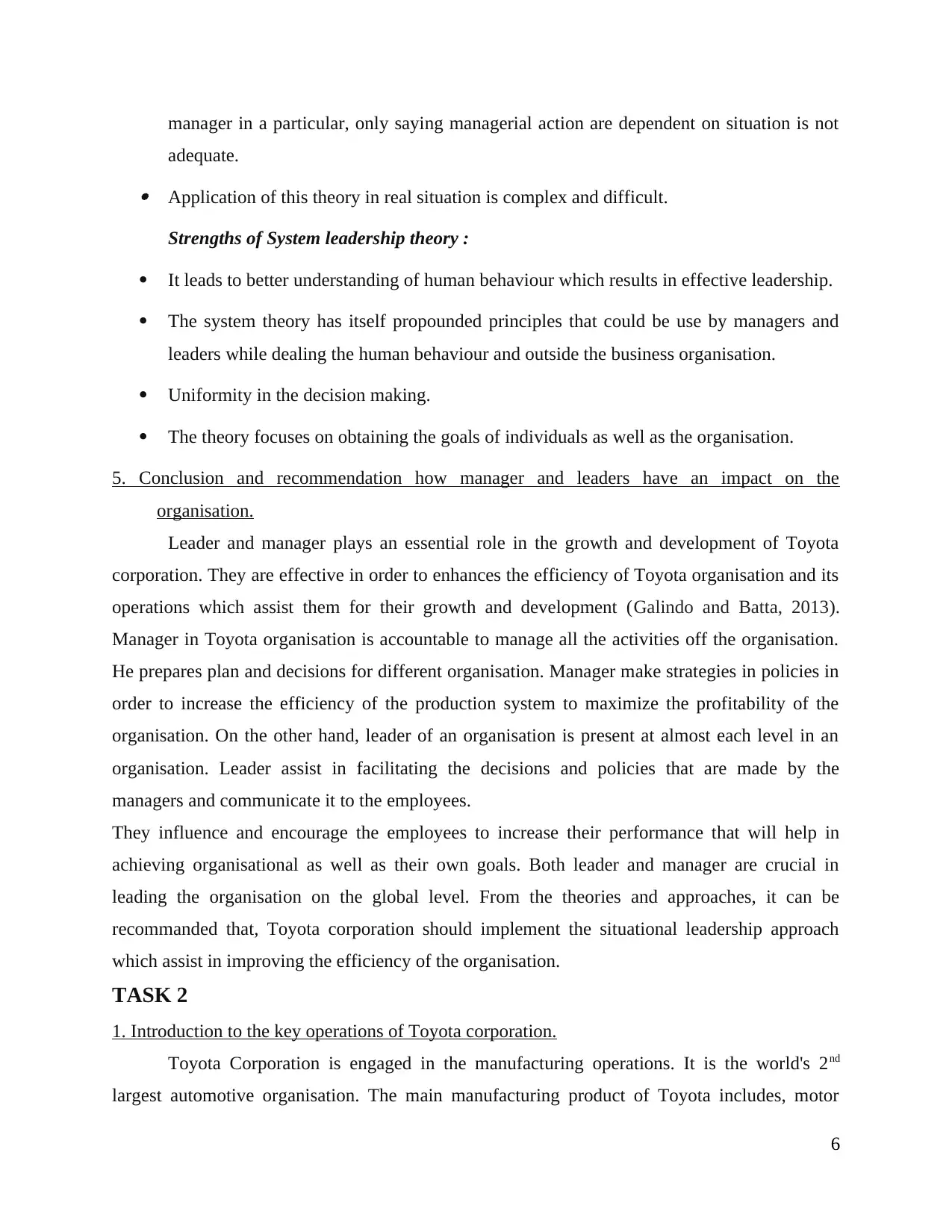
manager in a particular, only saying managerial action are dependent on situation is not
adequate. Application of this theory in real situation is complex and difficult.
Strengths of System leadership theory :
It leads to better understanding of human behaviour which results in effective leadership.
The system theory has itself propounded principles that could be use by managers and
leaders while dealing the human behaviour and outside the business organisation.
Uniformity in the decision making.
The theory focuses on obtaining the goals of individuals as well as the organisation.
5. Conclusion and recommendation how manager and leaders have an impact on the
organisation.
Leader and manager plays an essential role in the growth and development of Toyota
corporation. They are effective in order to enhances the efficiency of Toyota organisation and its
operations which assist them for their growth and development (Galindo and Batta, 2013).
Manager in Toyota organisation is accountable to manage all the activities off the organisation.
He prepares plan and decisions for different organisation. Manager make strategies in policies in
order to increase the efficiency of the production system to maximize the profitability of the
organisation. On the other hand, leader of an organisation is present at almost each level in an
organisation. Leader assist in facilitating the decisions and policies that are made by the
managers and communicate it to the employees.
They influence and encourage the employees to increase their performance that will help in
achieving organisational as well as their own goals. Both leader and manager are crucial in
leading the organisation on the global level. From the theories and approaches, it can be
recommanded that, Toyota corporation should implement the situational leadership approach
which assist in improving the efficiency of the organisation.
TASK 2
1. Introduction to the key operations of Toyota corporation.
Toyota Corporation is engaged in the manufacturing operations. It is the world's 2nd
largest automotive organisation. The main manufacturing product of Toyota includes, motor
6
adequate. Application of this theory in real situation is complex and difficult.
Strengths of System leadership theory :
It leads to better understanding of human behaviour which results in effective leadership.
The system theory has itself propounded principles that could be use by managers and
leaders while dealing the human behaviour and outside the business organisation.
Uniformity in the decision making.
The theory focuses on obtaining the goals of individuals as well as the organisation.
5. Conclusion and recommendation how manager and leaders have an impact on the
organisation.
Leader and manager plays an essential role in the growth and development of Toyota
corporation. They are effective in order to enhances the efficiency of Toyota organisation and its
operations which assist them for their growth and development (Galindo and Batta, 2013).
Manager in Toyota organisation is accountable to manage all the activities off the organisation.
He prepares plan and decisions for different organisation. Manager make strategies in policies in
order to increase the efficiency of the production system to maximize the profitability of the
organisation. On the other hand, leader of an organisation is present at almost each level in an
organisation. Leader assist in facilitating the decisions and policies that are made by the
managers and communicate it to the employees.
They influence and encourage the employees to increase their performance that will help in
achieving organisational as well as their own goals. Both leader and manager are crucial in
leading the organisation on the global level. From the theories and approaches, it can be
recommanded that, Toyota corporation should implement the situational leadership approach
which assist in improving the efficiency of the organisation.
TASK 2
1. Introduction to the key operations of Toyota corporation.
Toyota Corporation is engaged in the manufacturing operations. It is the world's 2nd
largest automotive organisation. The main manufacturing product of Toyota includes, motor
6
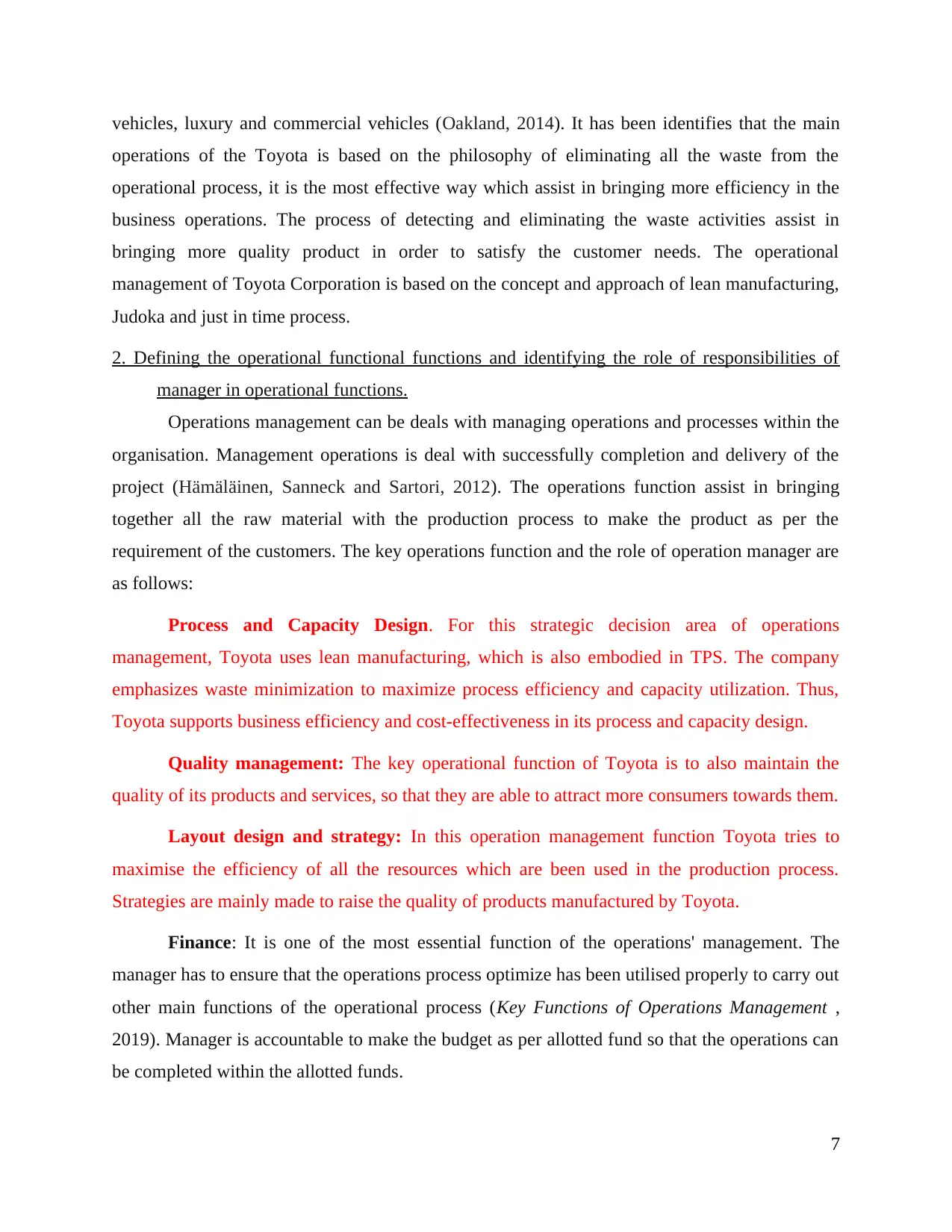
vehicles, luxury and commercial vehicles (Oakland, 2014). It has been identifies that the main
operations of the Toyota is based on the philosophy of eliminating all the waste from the
operational process, it is the most effective way which assist in bringing more efficiency in the
business operations. The process of detecting and eliminating the waste activities assist in
bringing more quality product in order to satisfy the customer needs. The operational
management of Toyota Corporation is based on the concept and approach of lean manufacturing,
Judoka and just in time process.
2. Defining the operational functional functions and identifying the role of responsibilities of
manager in operational functions.
Operations management can be deals with managing operations and processes within the
organisation. Management operations is deal with successfully completion and delivery of the
project (Hämäläinen, Sanneck and Sartori, 2012). The operations function assist in bringing
together all the raw material with the production process to make the product as per the
requirement of the customers. The key operations function and the role of operation manager are
as follows:
Process and Capacity Design. For this strategic decision area of operations
management, Toyota uses lean manufacturing, which is also embodied in TPS. The company
emphasizes waste minimization to maximize process efficiency and capacity utilization. Thus,
Toyota supports business efficiency and cost-effectiveness in its process and capacity design.
Quality management: The key operational function of Toyota is to also maintain the
quality of its products and services, so that they are able to attract more consumers towards them.
Layout design and strategy: In this operation management function Toyota tries to
maximise the efficiency of all the resources which are been used in the production process.
Strategies are mainly made to raise the quality of products manufactured by Toyota.
Finance: It is one of the most essential function of the operations' management. The
manager has to ensure that the operations process optimize has been utilised properly to carry out
other main functions of the operational process (Key Functions of Operations Management ,
2019). Manager is accountable to make the budget as per allotted fund so that the operations can
be completed within the allotted funds.
7
operations of the Toyota is based on the philosophy of eliminating all the waste from the
operational process, it is the most effective way which assist in bringing more efficiency in the
business operations. The process of detecting and eliminating the waste activities assist in
bringing more quality product in order to satisfy the customer needs. The operational
management of Toyota Corporation is based on the concept and approach of lean manufacturing,
Judoka and just in time process.
2. Defining the operational functional functions and identifying the role of responsibilities of
manager in operational functions.
Operations management can be deals with managing operations and processes within the
organisation. Management operations is deal with successfully completion and delivery of the
project (Hämäläinen, Sanneck and Sartori, 2012). The operations function assist in bringing
together all the raw material with the production process to make the product as per the
requirement of the customers. The key operations function and the role of operation manager are
as follows:
Process and Capacity Design. For this strategic decision area of operations
management, Toyota uses lean manufacturing, which is also embodied in TPS. The company
emphasizes waste minimization to maximize process efficiency and capacity utilization. Thus,
Toyota supports business efficiency and cost-effectiveness in its process and capacity design.
Quality management: The key operational function of Toyota is to also maintain the
quality of its products and services, so that they are able to attract more consumers towards them.
Layout design and strategy: In this operation management function Toyota tries to
maximise the efficiency of all the resources which are been used in the production process.
Strategies are mainly made to raise the quality of products manufactured by Toyota.
Finance: It is one of the most essential function of the operations' management. The
manager has to ensure that the operations process optimize has been utilised properly to carry out
other main functions of the operational process (Key Functions of Operations Management ,
2019). Manager is accountable to make the budget as per allotted fund so that the operations can
be completed within the allotted funds.
7
⊘ This is a preview!⊘
Do you want full access?
Subscribe today to unlock all pages.

Trusted by 1+ million students worldwide
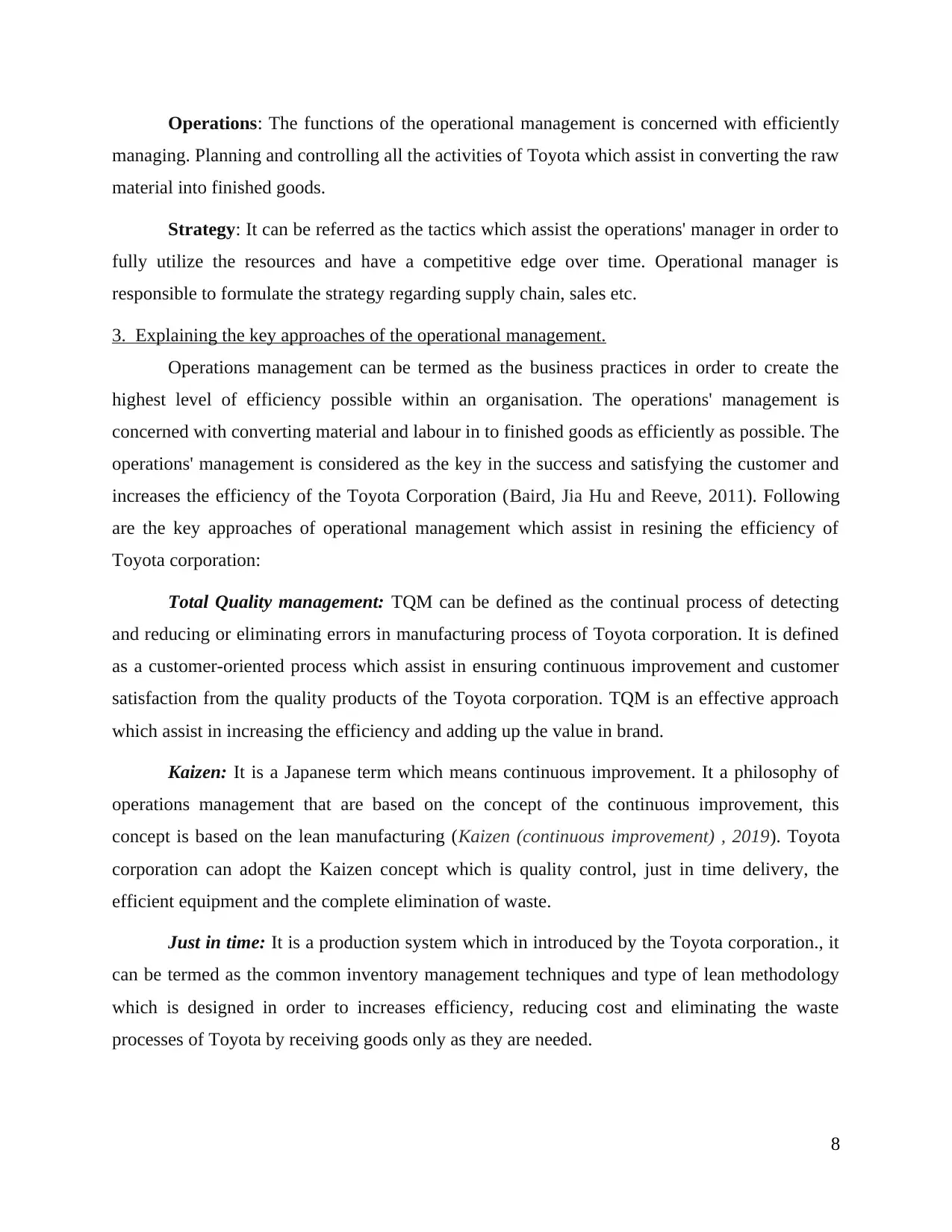
Operations: The functions of the operational management is concerned with efficiently
managing. Planning and controlling all the activities of Toyota which assist in converting the raw
material into finished goods.
Strategy: It can be referred as the tactics which assist the operations' manager in order to
fully utilize the resources and have a competitive edge over time. Operational manager is
responsible to formulate the strategy regarding supply chain, sales etc.
3. Explaining the key approaches of the operational management.
Operations management can be termed as the business practices in order to create the
highest level of efficiency possible within an organisation. The operations' management is
concerned with converting material and labour in to finished goods as efficiently as possible. The
operations' management is considered as the key in the success and satisfying the customer and
increases the efficiency of the Toyota Corporation (Baird, Jia Hu and Reeve, 2011). Following
are the key approaches of operational management which assist in resining the efficiency of
Toyota corporation:
Total Quality management: TQM can be defined as the continual process of detecting
and reducing or eliminating errors in manufacturing process of Toyota corporation. It is defined
as a customer-oriented process which assist in ensuring continuous improvement and customer
satisfaction from the quality products of the Toyota corporation. TQM is an effective approach
which assist in increasing the efficiency and adding up the value in brand.
Kaizen: It is a Japanese term which means continuous improvement. It a philosophy of
operations management that are based on the concept of the continuous improvement, this
concept is based on the lean manufacturing (Kaizen (continuous improvement) , 2019). Toyota
corporation can adopt the Kaizen concept which is quality control, just in time delivery, the
efficient equipment and the complete elimination of waste.
Just in time: It is a production system which in introduced by the Toyota corporation., it
can be termed as the common inventory management techniques and type of lean methodology
which is designed in order to increases efficiency, reducing cost and eliminating the waste
processes of Toyota by receiving goods only as they are needed.
8
managing. Planning and controlling all the activities of Toyota which assist in converting the raw
material into finished goods.
Strategy: It can be referred as the tactics which assist the operations' manager in order to
fully utilize the resources and have a competitive edge over time. Operational manager is
responsible to formulate the strategy regarding supply chain, sales etc.
3. Explaining the key approaches of the operational management.
Operations management can be termed as the business practices in order to create the
highest level of efficiency possible within an organisation. The operations' management is
concerned with converting material and labour in to finished goods as efficiently as possible. The
operations' management is considered as the key in the success and satisfying the customer and
increases the efficiency of the Toyota Corporation (Baird, Jia Hu and Reeve, 2011). Following
are the key approaches of operational management which assist in resining the efficiency of
Toyota corporation:
Total Quality management: TQM can be defined as the continual process of detecting
and reducing or eliminating errors in manufacturing process of Toyota corporation. It is defined
as a customer-oriented process which assist in ensuring continuous improvement and customer
satisfaction from the quality products of the Toyota corporation. TQM is an effective approach
which assist in increasing the efficiency and adding up the value in brand.
Kaizen: It is a Japanese term which means continuous improvement. It a philosophy of
operations management that are based on the concept of the continuous improvement, this
concept is based on the lean manufacturing (Kaizen (continuous improvement) , 2019). Toyota
corporation can adopt the Kaizen concept which is quality control, just in time delivery, the
efficient equipment and the complete elimination of waste.
Just in time: It is a production system which in introduced by the Toyota corporation., it
can be termed as the common inventory management techniques and type of lean methodology
which is designed in order to increases efficiency, reducing cost and eliminating the waste
processes of Toyota by receiving goods only as they are needed.
8
Paraphrase This Document
Need a fresh take? Get an instant paraphrase of this document with our AI Paraphraser
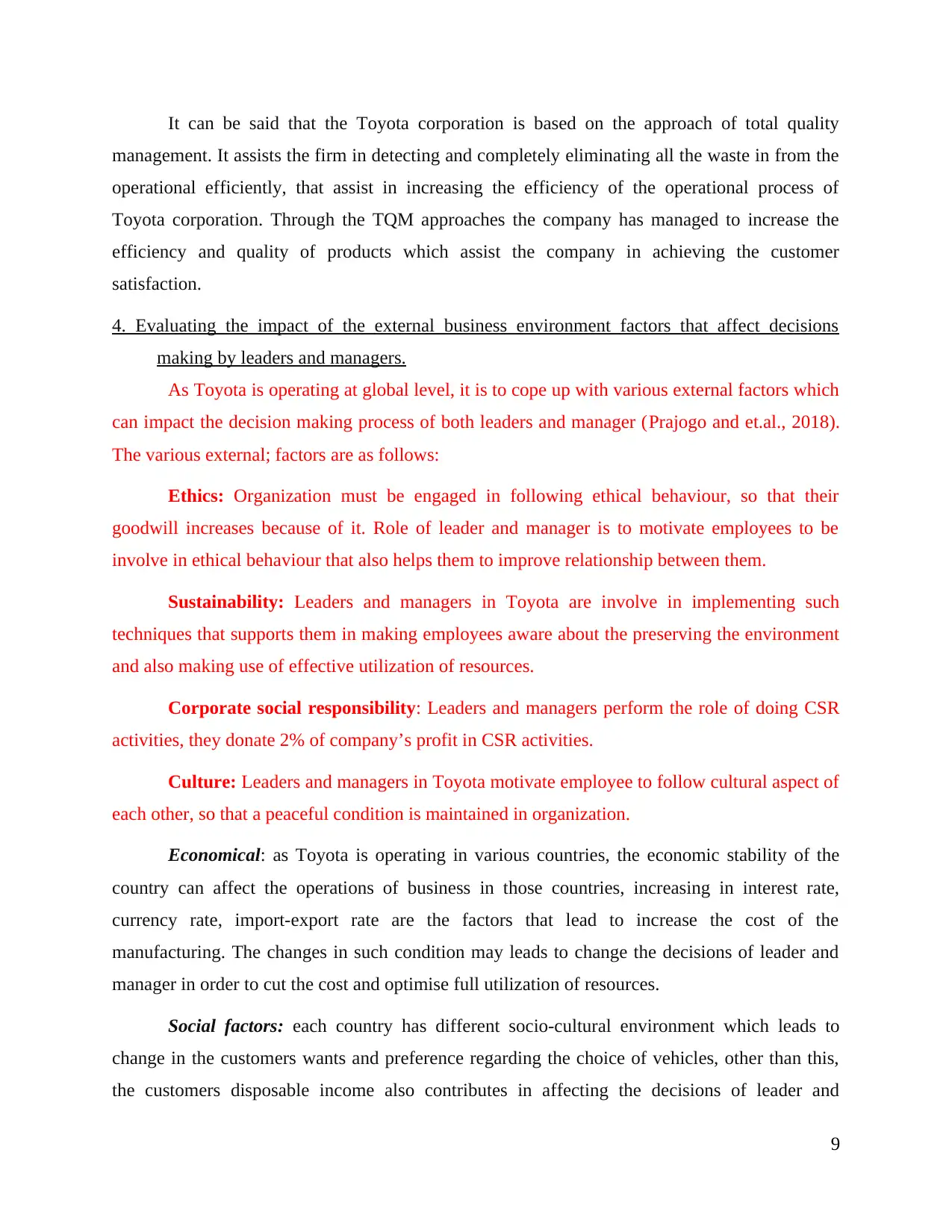
It can be said that the Toyota corporation is based on the approach of total quality
management. It assists the firm in detecting and completely eliminating all the waste in from the
operational efficiently, that assist in increasing the efficiency of the operational process of
Toyota corporation. Through the TQM approaches the company has managed to increase the
efficiency and quality of products which assist the company in achieving the customer
satisfaction.
4. Evaluating the impact of the external business environment factors that affect decisions
making by leaders and managers.
As Toyota is operating at global level, it is to cope up with various external factors which
can impact the decision making process of both leaders and manager (Prajogo and et.al., 2018).
The various external; factors are as follows:
Ethics: Organization must be engaged in following ethical behaviour, so that their
goodwill increases because of it. Role of leader and manager is to motivate employees to be
involve in ethical behaviour that also helps them to improve relationship between them.
Sustainability: Leaders and managers in Toyota are involve in implementing such
techniques that supports them in making employees aware about the preserving the environment
and also making use of effective utilization of resources.
Corporate social responsibility: Leaders and managers perform the role of doing CSR
activities, they donate 2% of company’s profit in CSR activities.
Culture: Leaders and managers in Toyota motivate employee to follow cultural aspect of
each other, so that a peaceful condition is maintained in organization.
Economical: as Toyota is operating in various countries, the economic stability of the
country can affect the operations of business in those countries, increasing in interest rate,
currency rate, import-export rate are the factors that lead to increase the cost of the
manufacturing. The changes in such condition may leads to change the decisions of leader and
manager in order to cut the cost and optimise full utilization of resources.
Social factors: each country has different socio-cultural environment which leads to
change in the customers wants and preference regarding the choice of vehicles, other than this,
the customers disposable income also contributes in affecting the decisions of leader and
9
management. It assists the firm in detecting and completely eliminating all the waste in from the
operational efficiently, that assist in increasing the efficiency of the operational process of
Toyota corporation. Through the TQM approaches the company has managed to increase the
efficiency and quality of products which assist the company in achieving the customer
satisfaction.
4. Evaluating the impact of the external business environment factors that affect decisions
making by leaders and managers.
As Toyota is operating at global level, it is to cope up with various external factors which
can impact the decision making process of both leaders and manager (Prajogo and et.al., 2018).
The various external; factors are as follows:
Ethics: Organization must be engaged in following ethical behaviour, so that their
goodwill increases because of it. Role of leader and manager is to motivate employees to be
involve in ethical behaviour that also helps them to improve relationship between them.
Sustainability: Leaders and managers in Toyota are involve in implementing such
techniques that supports them in making employees aware about the preserving the environment
and also making use of effective utilization of resources.
Corporate social responsibility: Leaders and managers perform the role of doing CSR
activities, they donate 2% of company’s profit in CSR activities.
Culture: Leaders and managers in Toyota motivate employee to follow cultural aspect of
each other, so that a peaceful condition is maintained in organization.
Economical: as Toyota is operating in various countries, the economic stability of the
country can affect the operations of business in those countries, increasing in interest rate,
currency rate, import-export rate are the factors that lead to increase the cost of the
manufacturing. The changes in such condition may leads to change the decisions of leader and
manager in order to cut the cost and optimise full utilization of resources.
Social factors: each country has different socio-cultural environment which leads to
change in the customers wants and preference regarding the choice of vehicles, other than this,
the customers disposable income also contributes in affecting the decisions of leader and
9
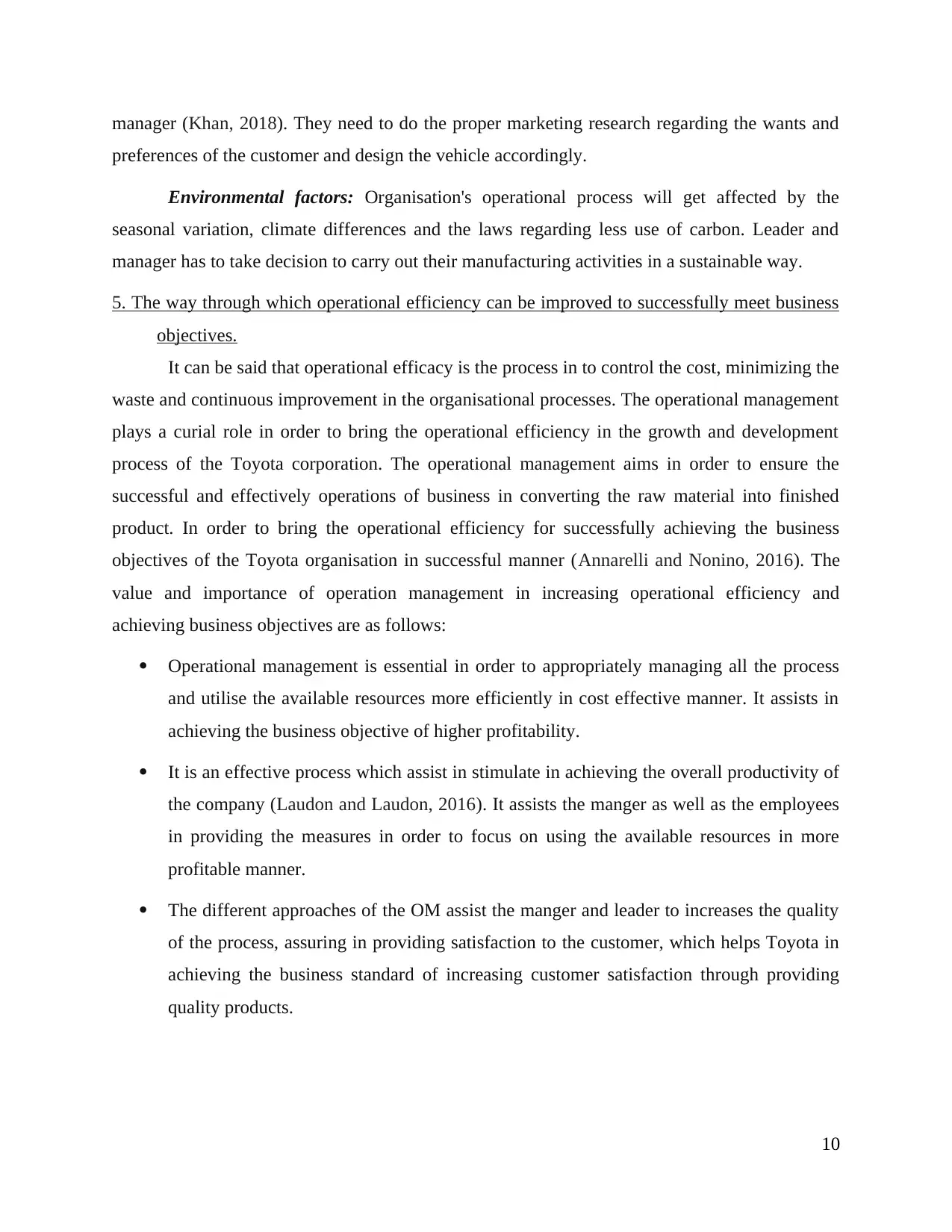
manager (Khan, 2018). They need to do the proper marketing research regarding the wants and
preferences of the customer and design the vehicle accordingly.
Environmental factors: Organisation's operational process will get affected by the
seasonal variation, climate differences and the laws regarding less use of carbon. Leader and
manager has to take decision to carry out their manufacturing activities in a sustainable way.
5. The way through which operational efficiency can be improved to successfully meet business
objectives.
It can be said that operational efficacy is the process in to control the cost, minimizing the
waste and continuous improvement in the organisational processes. The operational management
plays a curial role in order to bring the operational efficiency in the growth and development
process of the Toyota corporation. The operational management aims in order to ensure the
successful and effectively operations of business in converting the raw material into finished
product. In order to bring the operational efficiency for successfully achieving the business
objectives of the Toyota organisation in successful manner (Annarelli and Nonino, 2016). The
value and importance of operation management in increasing operational efficiency and
achieving business objectives are as follows:
Operational management is essential in order to appropriately managing all the process
and utilise the available resources more efficiently in cost effective manner. It assists in
achieving the business objective of higher profitability.
It is an effective process which assist in stimulate in achieving the overall productivity of
the company (Laudon and Laudon, 2016). It assists the manger as well as the employees
in providing the measures in order to focus on using the available resources in more
profitable manner.
The different approaches of the OM assist the manger and leader to increases the quality
of the process, assuring in providing satisfaction to the customer, which helps Toyota in
achieving the business standard of increasing customer satisfaction through providing
quality products.
10
preferences of the customer and design the vehicle accordingly.
Environmental factors: Organisation's operational process will get affected by the
seasonal variation, climate differences and the laws regarding less use of carbon. Leader and
manager has to take decision to carry out their manufacturing activities in a sustainable way.
5. The way through which operational efficiency can be improved to successfully meet business
objectives.
It can be said that operational efficacy is the process in to control the cost, minimizing the
waste and continuous improvement in the organisational processes. The operational management
plays a curial role in order to bring the operational efficiency in the growth and development
process of the Toyota corporation. The operational management aims in order to ensure the
successful and effectively operations of business in converting the raw material into finished
product. In order to bring the operational efficiency for successfully achieving the business
objectives of the Toyota organisation in successful manner (Annarelli and Nonino, 2016). The
value and importance of operation management in increasing operational efficiency and
achieving business objectives are as follows:
Operational management is essential in order to appropriately managing all the process
and utilise the available resources more efficiently in cost effective manner. It assists in
achieving the business objective of higher profitability.
It is an effective process which assist in stimulate in achieving the overall productivity of
the company (Laudon and Laudon, 2016). It assists the manger as well as the employees
in providing the measures in order to focus on using the available resources in more
profitable manner.
The different approaches of the OM assist the manger and leader to increases the quality
of the process, assuring in providing satisfaction to the customer, which helps Toyota in
achieving the business standard of increasing customer satisfaction through providing
quality products.
10
⊘ This is a preview!⊘
Do you want full access?
Subscribe today to unlock all pages.

Trusted by 1+ million students worldwide
1 out of 15
Related Documents
Your All-in-One AI-Powered Toolkit for Academic Success.
+13062052269
info@desklib.com
Available 24*7 on WhatsApp / Email
![[object Object]](/_next/static/media/star-bottom.7253800d.svg)
Unlock your academic potential
Copyright © 2020–2025 A2Z Services. All Rights Reserved. Developed and managed by ZUCOL.





